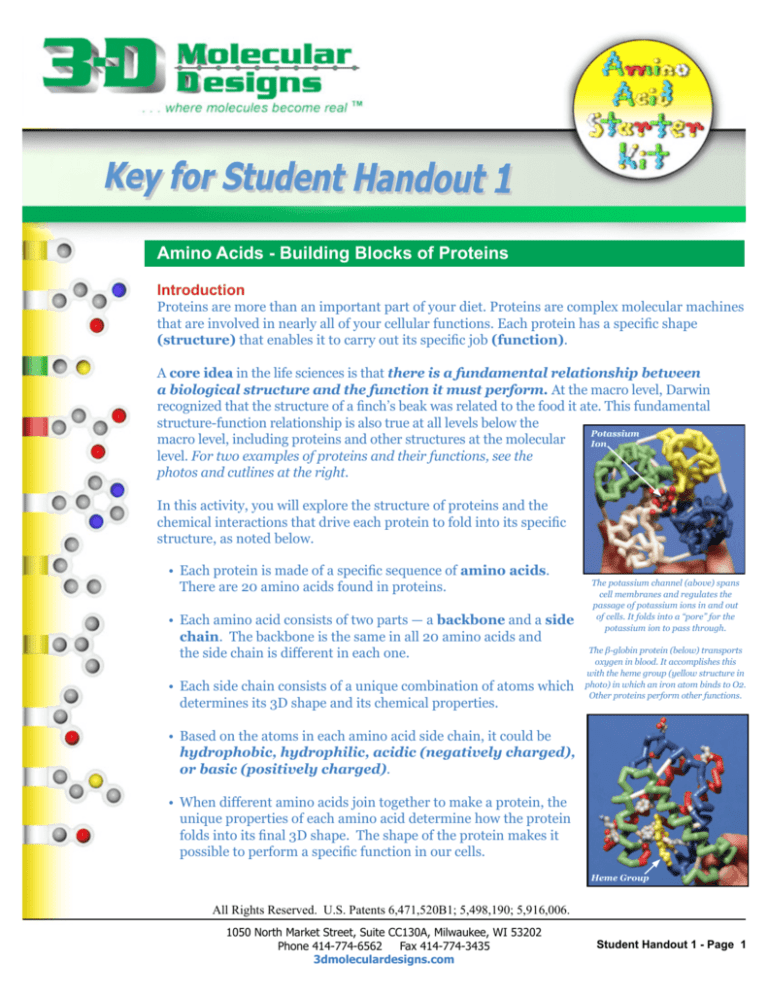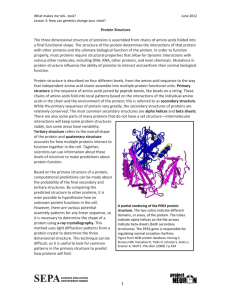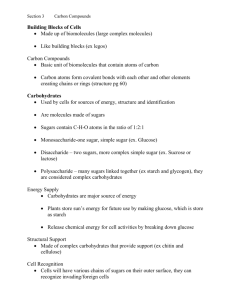
Amino Acids - Building Blocks of Proteins
Introduction
Proteins are more than an important part of your diet. Proteins are complex molecular machines
that are involved in nearly all of your cellular functions. Each protein has a specific shape
(structure) that enables it to carry out its specific job (function).
A core idea in the life sciences is that there is a fundamental relationship between
a biological structure and the function it must perform. At the macro level, Darwin
recognized that the structure of a finch’s beak was related to the food it ate. This fundamental
structure-function relationship is also true at all levels below the
Potassium
macro level, including proteins and other structures at the molecular
Ion
level. For two examples of proteins and their functions, see the
photos and cutlines at the right.
In this activity, you will explore the structure of proteins and the
chemical interactions that drive each protein to fold into its specific
structure, as noted below.
• Each protein is made of a specific sequence of amino acids.
There are 20 amino acids found in proteins.
• Each amino acid consists of two parts — a backbone and a side
chain. The backbone is the same in all 20 amino acids and
the side chain is different in each one.
• Each side chain consists of a unique combination of atoms which
determines its 3D shape and its chemical properties.
• Based on the atoms in each amino acid side chain, it could be
hydrophobic, hydrophilic, acidic (negatively charged),
or basic (positively charged).
• When different amino acids join together to make a protein, the
unique properties of each amino acid determine how the protein
folds into its final 3D shape. The shape of the protein makes it
possible to perform a specific function in our cells.
The potassium channel (above) spans
cell membranes and regulates the
passage of potassium ions in and out
of cells. It folds into a “pore” for the
potassium ion to pass through.
The β-globin protein (below) transports
oxygen in blood. It accomplishes this
with the heme group (yellow structure in
photo) in which an iron atom binds to O2.
Other proteins perform other functions.
Heme Group
All Rights Reserved. U.S. Patents 6,471,520B1; 5,498,190; 5,916,006.
1050 North Market Street, Suite CC130A, Milwaukee, WI 53202
Phone 414-774-6562
Fax 414-774-3435
3dmoleculardesigns.com
Student Handout 1 - Page 1
Chemical Properties Circle & Amino Acid Chart
Hydrophobic and Hydrophilic Properties
What do you think hydrophobic means? Separate the word ‘hydrophobic’ into its two parts —
hydro and phobic. Hydro means water and phobia means fear or dislike, so hydrophobic side
chains don’t like water. Hydrophobic side chains are also referred to as non-polar side chains.
Now can you guess what hydrophilic means? Philic means likes or attracted to, so hydrophilic
side chains like water. Hydrophilic side chains are also referred to as polar side chains.
Acidic (Negatively Charged) and Basic (Positively Charged) Properties
Can you think of acids you have around your house? Lemon and fruit juices, vinegar and phosphoric
acid (in dark sodas) are common household acids. Acids taste sour and are typically liquids.
Can you think of bases you have around your house? Tums®, baking soda, drain cleaner and soap
are common bases. Bases taste bitter and can be a liquid or solid.
What happens when you mix lemon juice or vinegar with baking soda? They neutralize each other,
in a bubbling chemical reaction.
Preparation
The activities described in this handout primarily focus on amino acid side chains. They will
help you understand how the unique properties of each side chain contribute to the structure
and function of a protein.
First look at the components in your Amino Acid Starter Kit©. Make sure your 1-group set has:
1. 1 Chemical Properties Circle
2. 1 Laminated Amino Acid Side Chain
Chart
3. 4’ Mini toober
4. 1 Set of Red and Blue Endcaps
5. 22 Clear Bumpers
6. 22Amino Acid Side Chains
-1 each of the 20 amino acids
-1 additional cysteine and
-1 additional histidine
7. 22Plastic Clips
-8 yellow
(also shown on
-8 white
mini toober)
-2 blue
-2 red
Photo shows a 1-Group Amino Acid Starter Kit.
-2 green
8. 6 Hydrogen Bond Connectors
1050 North Market Street, Suite CC130A, Milwaukee, WI 53202
Phone 414-774-6562
Fax 414-774-3435
3dmoleculardesigns.com
Student Handout 1 - Page 2
Chemical Properties Circle (continued)
The colored areas on the Chemical Properties Circle, the color coding on the Amino Acid Side
Chain Chart, the key below and the colored clips show the chemical properties of side chains.
KEY
Hydrophobic Side Chains are Yellow
Hydrophilic Side Chains are White
Acidic Side Chains are Red
Basic Side Chains are Blue
Cysteine Side Chains are Green
Amino Acid Side Chain Chart
Directions
Select any side chain and a colored clip that corresponds to the
property of the side chain. Insert the side chain into the clip.
Place each amino acid side chain attached to its clip on the
bumper near its name and abbreviations. You will need to consult
the Amino Acid Side Chain Chart in your kit to find the name of
each side chain, so you can position it correctly on the circle.
Insert side chain into clip.
Place clip (with side chain
attached) onto the bumper.
Chemical Properties Circle with side chains and clips
1050 North Market Street, Suite CC130A, Milwaukee, WI 53202
Phone 414-774-6562
Fax 414-774-3435
3dmoleculardesigns.com
Student Handout 1 - Page 3
Chemical Properties Circle (continued)
After each side chain has been correctly positioned on the circle, look at the colored spheres in
each side chain. Scientists established a CPK coloring scheme (see chart below) to make it easier
to identify specific atoms in models of molecular structures.
KEY
Carbon is Gray
Oxygen is Red
Nitrogen is Blue
Hydrogen is White
Sulfur is Yellow
Did you notice similarities of patterns in each group of side chains? Describe
your observations.
• Hydrophobic side chains primarily contain __________________
atoms.
carbon
• Acidic side chains contain two ____________________
atoms. This is called a
oxygen
carboxylic acid functional group.
• Basic side chains contain ____________________
atoms. This is called an amino
one or two nitrogen
functional group.
• Hydrophilic side chains have various combinations of
______________________________________________________________
oxygen, nitrogen and sulfur and carbon atoms.
______________________________________________________________
• An exception to the above observation is:
______________________________________________________________
Tryptophan - a hydrophobic amino acid that contains a nitrogen atom.
______________________________________________________________
• Optional Activity - Amino Acids Jmol (See 3dmoleculardesigns.com/Teacher-Resources/
Amino-Acid-Starter-Kit/Jmols-and-Tutorials.htm.)
1050 North Market Street, Suite CC130A, Milwaukee, WI 53202
Phone 414-774-6562
Fax 414-774-3435
3dmoleculardesigns.com
Student Handout 1 - Page 4
Folding a 15-Amino Acid Protein
Once you have explored the chemical properties and atomic composition of each side chain,
think about how proteins spontaneously fold into their 3D shapes.
Predict what causes proteins to fold into their 3D shapes.
• Which side chains might position themselves on the interior of a protein, where they
are shielded from water?
_____________________________________________________________
The hydrophobic amino acids - tryptophan, leucine, isoleucine, valine, proline,
_____________________________________________________________
alanine and glycine.
_____________________________________________________________
• From your experience with static electricity, which side chains might be attracted to
each other?
The basic amino acids (+ charge) and the acidic amino acids (- charge).
_____________________________________________________________
_____________________________________________________________
• Would the final shape of a protein be a high energy state or a low energy state for all of
the atoms in the structure?
_____________________________________________________________
A low energy state.
_____________________________________________________________
Why?
_____________________________________________________________
A low energy state is more stable than a high energy state.
_____________________________________________________________
1. Unwind the 4-foot mini toober (foam-covered wire) that is in your kit. Place a blue endcap
on one end and the red endcap on the other end. The blue endcap represents the N-terminus
(the beginning) of the protein and the red endcap represents the C-terminus (the end) of the
protein (see photo on next page).
2. Choose 15 side chains from the chemical properties
circle as indicated in the chart shown right.
Mix the side chains together and place them (in any
order you choose) on your mini toober.
KEY
6 Hydrophobic side chains
2 Acidic side chains
2 Basic side chains
2 Cysteine side chains
3 Hydrophilic side chains
1050 North Market Street, Suite CC130A, Milwaukee, WI 53202
Phone 414-774-6562
Fax 414-774-3435
3dmoleculardesigns.com
Student Handout 1 - Page 5
Folding a 15-Amino Acid Protein (continued)
3. You may want to use a ruler to place your side chains on you mini toober.
Beginning at the N-terminus of your mini toober, measure about three inches from the end
of your mini toober and slide the first colored clip with its side chain onto the mini toober.
(See photo.) Place the rest of the clips three inches apart until all are attached to the mini
toober.
• This drawing represents the backbone section of an
amino acid. What do you think the clips represent?
________________________________________
The alpha-carbon, because this is the atom that the
________________________________________
side chains are bonded to.
________________________________________
The sequence of amino acid side chains that
you determined when placing them on the mini
toober is called the primary structure of your
protein. As a general rule the final shape of a
protein is determined by its primary structure.
Remember that protein folding happens in the
watery environment of the cell.
1050 North Market Street, Suite CC130A, Milwaukee, WI 53202
Phone 414-774-6562
Fax 414-774-3435
3dmoleculardesigns.com
Student Handout 1 - Page 6
Folding a 15-Amino Acid Protein (continued)
4. Now you can begin to fold your 15-amino acid protein
according to the chemical properties of its side chains.
Remember all of these chemical properties affect the
protein at the same time.
A
Photo A — Hydrophobic Side Chains
Start by folding your protein so that all of the hydrophobic
(non-polar) side chains are buried on the inside of your
protein, where they will be hidden from polar water molecules.
Photo B — Acidic & Basic Side Chains
Fold your protein so the acidic and basic (charged) side
chains are on the outside surface of the protein. Place one
negative (acidic) side chain with one positive (basic) side chain
so that they come within one inch of each other and neutralize
each other. This positive-negative pairing helps stabilize your
protein.
B
Note: As you continue to fold your protein and apply each
new property listed below, you will probably find that some
of the side chains you previously positioned are no longer in
place. For example, when you paired a negatively charged side C
chain with a positively charged one, some of the hydrophobic
side chains probably moved to the outer surface of your
protein. Continue to fold until the hydrophobic ones are
buried on the inside again. Find a shape in which all the
properties apply simultaneously.
Photo C — Cysteine Side Chains
Fold your protein so that the two cysteine side chains are
positioned opposite each other on the inside of the protein
where they can form a covalent-disulfide bond that helps
stabilize your protein.
D
Photo D — Hydrophilic Side Chains
Continue to fold you protein making sure that your
hydrophilic (polar) side chains are also on the outside surface
of your protein where they can hydrogen bond with water.
The final shape of your protein when it is folded is called the
tertiary structure.
1050 North Market Street, Suite CC130A, Milwaukee, WI 53202
Phone 414-774-6562
Fax 414-774-3435
3dmoleculardesigns.com
Student Handout 1 - Page 7
15-Amino Acid Protein Questions
• What happened as you continued to fold your protein and applied each new chemical
property to your protein?
______________________________________________________________
It became more compact and more complicated.
______________________________________________________________
• Were you able to fold your protein so that all of the chemical properties were in effect at
the same time?
______________________________________________________________
Yes. (Note to teachers: some students may answer “No”.)
______________________________________________________________
• If not, do you have any ideas why you weren’t able to fold your protein in a way that
allowed all of the chemical properties to be in effect simultaneously?
______________________________________________________________
Some sequences simply do not allow for a single shape that simultaneously satisfies
______________________________________________________________
all the principles of chemistry that drive protein folding.
______________________________________________________________
• Did your protein look like the proteins other students folded?___________________
No
Explain.
______________________________________________________________
Because everyone had a different sequence of amino acids.
______________________________________________________________
• How many different proteins, 15 amino acid long, could you make given an unlimited
number of each of the 20 amino acids?
______________________________________________________________
2015 = 3.28 x 1019
______________________________________________________________
• Most real proteins are actually in the range of 300 amino acids long. How many
different possible proteins, 300 amino acids in length, could exist?
______________________________________________________________
20300 = 2 x 10390
______________________________________________________________
1050 North Market Street, Suite CC130A, Milwaukee, WI 53202
Phone 414-774-6562
Fax 414-774-3435
3dmoleculardesigns.com
Student Handout 1 - Page 8
15-Amino Acid Protein Questions (continued)
• Research how many different proteins
are found in the human body. Hint: how
many different genes are there in the human
genome*?
_______________________________
25,000 or 2.5 x 104
_______________________________
_______________________________
• Assuming that all human proteins are 300
amino acids long, what fraction of the total
number of possible different proteins is found
in the human body? ______________________________________________________________
1 x 10-386 = miniscule!
______________________________________________________________
• Why do you think there are fewer actual proteins than possible ones?
______________________________________________________________
Because only a relatively small number of amino acid sequences can adopt a stable shape that
______________________________________________________________
simultaneously satisfies all of the principles of chemistry.
* Completed in 2003, the Human Genome Project (HGP) was a 13-year project coordinated by the U.S.
Department of Energy and the National Institutes of Health. During the early years of the HGP, the Wellcome
Trust (U.K.) became a major partner; additional contributions came from Japan, France, Germany, China, and
others.
Project goals were to:
• Identify all of the approximately 20,000-25,000 genes in human DNA,
• Determine the sequences of the 3 billion chemical base pairs that make up human DNA,
• Store this information in databases,
• Improve tools for data analysis,
• Transfer related technologies to the private sector, and
• Address the ethical, legal, and social issues (ELSI) that may arise from the project.**
** U.S. Department of Energy Genome Programs website http://ornl.gov/sci/techresources/Human_
Genome/home.shtml
• Optional Discussion: Genes can code for multiple proteins through the process of
alternative splicing.
1050 North Market Street, Suite CC130A, Milwaukee, WI 53202
Phone 414-774-6562
Fax 414-774-3435
3dmoleculardesigns.com
Student Handout 1 - Page 9
15-Amino Acid Protein Questions (continued)
Record the sequence of amino acids in your protein, starting with the N-terminus (blue endcap). Use
the single letter abbreviation for each amino acid (Methionine = M).
This is the primary structure of your protein.
In the space below, sketch the tertiary structure of your protein.
Discussion
Proteins perform critical functions in all our cells. Without proteins, life wouldn’t exist. With
your group or class, can you think of some of some specific proteins and describe what function
they perform? Proteins are involved in your metabolism, cell structure, immune system, DNA
expression, protein folding, transport, movement, communication and storing energy.
• Optional Jmol Activity
- Basic Priciples of Chemistry that Drive Protein Folding Part 1 Jmol
- Basic Priciples of Chemistry that Drive Protein Folding Part 2 Jmol
(See 3dmoleculardesigns.com/Teacher-Resources/Amino-Acid-Starter-Kit/Jmolsand-Tutorials.htm.)
The next student handout provides folding activities and information that will help you
understand the secondary structure of proteins.
1050 North Market Street, Suite CC130A, Milwaukee, WI 53202
Phone 414-774-6562
Fax 414-774-3435
3dmoleculardesigns.com
Student Handout 1 - Page 10









